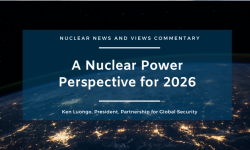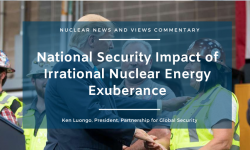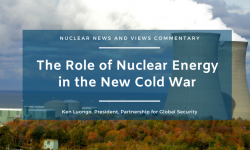At the Dubai climate change meeting in November 2023, almost two dozen countries agreed to triple the deployment of nuclear energy by 2050. The U.S. supported that commitment, China eventually did, and Russia remained silent.
Ten months later, China has approved 11 new reactors, Russia is proposing 34 new units by 2042, and the U.S. has announced no plans for additional reactor construction. For the previous period of 2019-2023, China approved “six, four, five, 10, and 10” new reactors in those respective years.

Despite the Secretary of Energy calling for the addition of “200 more megawatts by 2050” of nuclear energy when visiting the newly completed Vogtle plant in May, the U.S. at the moment is not on track to deploy any new reactors in the foreseeable future.
American allies that are party to the Dubai declaration, however, are moving forward. South Korea, has approved two new reactors, France and the U.K. are also accelerating new reactor construction. And nations in Central and Eastern Europe are planning to initiate or expand their nuclear energy capacity, including Poland, Bulgaria, the Czech Republic, Romania, and Hungary.
Still, since the COP, there have been important victories for the U.S. Poland has chosen the Westinghouse Electric Company to build its first three nuclear power plants, the company’s AP-1000 reactors are under construction in China, and it is in competition for reactor contracts in Central and Eastern Europe, as well as potentially the Ukraine and U.K. Westinghouse also is producing VVER reactor fuel to replace reliance on Russia.
The U.S. also is supporting its existing domestic reactor fleet, which currently is the largest fleet in the world. This includes the preservation of the slated-to-be-closed Diablo Canyon reactor in California and the resuscitation of the mothballed Palisades nuclear plant in Michigan. There also is discussion of reopening Three Mile Island to power data centers.
Further, U.S. is pouring billions into the development and demonstration of next-generation smaller nuclear reactors to serve energy and industrial needs around the world. And it has restarted uranium enrichment to produce HALEU to fuel these reactors.
But the country is facing some significant headwinds that are hindering progress. A major change will be the installation of a new government administration in January 2025. There is the real possibility of frozen or uncertain policy direction depending on who is elected. And delays are certain as new top-level personnel are selected and vetted.
The Harris nuclear energy policy is not clear. She cast the deciding vote in favor of the Inflation Reduction Act, that included billions of dollars for nuclear energy. But, as a candidate, she has not spoken specifically about the role of nuclear power for energy production or carbon reduction.
The Trump nuclear energy policy is clear. The Republican convention platform stated, that he will, “unleash Energy Production from all sources, including nuclear.” But the Trump approach to alliance management could impede nuclear construction overseas, and supply chain development at home, particularly in projects where the U.S. and South Korea are interdependent.
A dispute that originated during the Trump administration over whether Westinghouse intellectual property resides in the Korean APR-1400 reactor continues to simmer. This, at the very least, is impacting the ability to construct two new Korean reactors in the Czech Republic.
The U.S. next-generation reactor initiative also is encountering setbacks in the real world, offsetting the happy talk epitomized by, “pictures of people in business suits shaking hands in front of a camera, flags in the background, and announcements of promises to study deployment.”
Progress is proceeding with the development of these reactors, commitments are being made dependent on demonstration and licensing, and sites are being cleared for deployment.
But there is an undercurrent of concern about the pace of progress and whether these reactors will really be ready by the early 2030s. There are questions about the efficiency of the licensing process and what setbacks will be encountered when new technologies are demonstrated.
Then there are questions about what markets and nations are ready to operate these advanced technologies and whether the U.S. can counter the tantalizing technological-financial offerings of Russia and China and build an reactor “order book.”
At the root of the challenges facing America’s objective of expanding nuclear energy at home and abroad is the lack of a cohesive strategy for how to achieve the goal. Creating this plan is essential for success.
Now that the government has handed out its legislative and financial goodies to spark nuclear power advancement, it can’t be content to just hand off the hard work of market capture and reactor deployment and to the U.S. commercial nuclear industry. That is not a winning plan, and it won’t work. The low hanging fruit won’t last and prevailing in the tougher markets where countries have financial, governance, or political challenges, requires a strong commercial-government partnership.
If the U.S. is really serious about achieving even a small percentage of the nuclear growth proposed in Dubai, and beating out Russia and China while doing it, it is going to need a detailed private-public technology, financing, market, and geopolitical strategy to make it a reality.
Without that roadmap, the ability to deploy American nuclear power to address multiple challenges in this century, at home and abroad, will be lost and likely for good.
Ken Luongo, President, Partnership for Global Security






